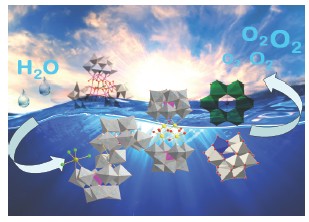

Progress in Polyoxometalates-Catalyzed Water Oxidation
Received date: 2013-10-12
Online published: 2013-12-07
Supported by
Project supported by the National Natural Science Foundation of China (No. 21173105).
H2 is considered to be a clean, efficiently and renewable energy because H2O is the only product when H2 combines with O2. The splitting of water into H2 and O2 by sunlight is viewed as one of the most promising ways to produce clean and sustainable energy that is expected to meet the future need as environmentally friendly and renewable energy sources. Artificial photosynthesis water splitting is currently the most ideal energy conversion mode, and it has attracted many researchers' interest. Through this way, H2 can be separated from reaction system or in-situ used when a solar cell designed together. Water oxidation is identified as the bottleneck of water splitting because it requires a multi-electron stepwise building up of very high redox potentials. So, development of efficient and stable water oxidation catalysts (WOCs) is the key step in overall water splitting. Polyoxometalates (POMs) are a versatile family of early transition-metal oxide nanoclusters. Owing to the unmatched physical and chemical properties of POMs, they have been widely applied in catalysis, medicine, nanotechnology and materials science. Development of POMs as WOCs has given rise to more and more interesting of researchers because the all-inorganic ligands of POMs can resist the strong oxidizing environment of water oxidation reaction, which is a shortcoming of many organometallic complex WOCs. POMs have the nature between metal oxides and molecular catalysts (the so-called molecular metal oxide), thus, this kind of WOC combines the stability benefit of heterogeneous WOCs and other molecular benefits of homogeneous WOCs, which give rise to the attention of researchers. Based on a considerable number of POMs have been designed as WOCs so far, it is necessary to carry on a review for previous POM-WOCs work. In this review, various different type transition metal substituted POMs as WOCs were described and commented in detail.

Song Fangyuan , Ding Yong , Zhao Chongchao . Progress in Polyoxometalates-Catalyzed Water Oxidation[J]. Acta Chimica Sinica, 2014 , 72(2) : 133 -144 . DOI: 10.6023/A13101052
[1] Du, P.; Eisenberg, R. Energy Environ. Sci. 2012, 5, 6012.
[2] Lewis, N. S.; Nocera, D. G. Proc. Natl. Acad. Sci. U. S. A. 2006, 103, 15729.
[3] Service, R. F. Science 2005, 309, 548.
[4] Hoffert, M. I.; Caldeira, K.; Jain, A. K.; Haites, E. F.; Harvey, L. D.; Potter, S. D.; Schlesinger, M. E.; Schneider, S. H.; Watts, R. G.; Wigley, T. M. Nature 1998, 395, 881.
[5] Fillol, J. L.; Codolà, Z.; Garcia-Bosch, I.; Gómez, L.; Pla, J. J.; Costas, M. Nat. Chem. 2011, 3, 807.
[6] Parent, A. R.; Crabtree, R. H.; Brudvig, G. W. Chem. Soc. Rev. 2013, 42, 2247.
[7] Liu, X.; Wang, F. Coord. Chem. Rev. 2012, 256, 1115.
[8] Sartorel, A.; Bonchio, M.; Campagna, S.; Scandola, F. Chem. Soc. Rev. 2013, 42, 2262.
[9] Osterloh, F. E. Chem. Soc. Rev. 2013, 42, 2294.
[10] McAlpin, J. G.; Stich, T. A.; Casey, W. H.; Britt, R. D. Coord. Chem. Rev. 2012, 256, 2445.
[11] Lin, Y.; Yuan, G.; Sheehan, S.; Zhou, S.; Wang, D. Energy Environ. Sci. 2011, 4, 4862.
[12] Graetzel, M. Acc. Chem. Res. 1981, 14, 376.
[13] Sartorel, A.; Carraro, M.; Toma, F. M.; Prato, M.; Bonchio, M. Energy Environ. Sci. 2012, 5, 5592.
[14] Cao, R.; Lai, W.; Du, P. Energy Environ. Sci. 2012, 5, 8134.
[15] Fukuzumi, S.; Yamada, Y. J. Mater. Chem. 2012, 22, 24284.
[16] Liang, Y.; An, X. Acta Chim. Sinica 1986, 44, 964. (梁永武, 安兴民, 化学学报, 1986, 44, 964.)
[17] Ling, L.; Chen, G.; Wang, W.; Chen, H.; Li, S.; Chen, C.; Liu, Q.; Kuang, T. Acta Chim. Sinica 2007, 65, 983. (凌琳, 陈桂英, 王文国, 陈惠, 李淑芹, 陈昌能, 刘秋田, 匡廷云, 化学学报, 2007, 65, 983.)
[18] Wan, Z.; Chen, S.; Jia, C.; Yan, W. Acta Chim. Sinica 2009, 67, 403. (万中全, 陈树楠, 贾春阳, 延卫, 化学学报, 2009, 67, 403.)
[19] Wen, F.; Yang, J.; Zong, X.; Ma, Y.; Xu, Q.; Ma, B.; Li, C. Prog. Chem. 2009, 21, 2285. (温福宇, 杨金辉, 宗旭, 马艺, 徐倩, 马宝军, 李灿, 化学进展, 2009, 21, 2285.)
[20] Han, Z.; Bond, A. M.; Zhao, C. Sci. China Chem. 2011, 54, 1877.
[21] Huang, Z.; Geletii, Y. V.; Musaev, D. G.; Hill, C. L.; Lian, T. Ind. Eng. Chem. Res. 2012, 51, 11850.
[22] Kanan, M. W.; Nocera, D. G. Science 2008, 321, 1072.
[23] Duan, L.; Bozoglian, F.; Mandal, S.; Stewart, B.; Privalov, T.; Llobet, A.; Sun, L. Nat. Chem. 2012, 4, 418.
[24] Ma, S. S. K.; Maeda, K.; Abe, R.; Domen, K. Energy Environ. Sci. 2012, 5, 8390.
[25] Hoang, S.; Guo, S.; Hahn, N. T.; Bard, A. J.; Mullins, C. B. Nano Lett. 2012, 12, 26.
[26] Duan, L.; Xu, Y.; Zhang, P.; Wang, M.; Sun, L. Inorg. Chem. 2010, 49, 209.
[27] Wang, E.; Hu, C.; Xu, L. Introduction of Polyoxometalate Chemistry, Chemical Industry Press, Beijing, 1998. (王恩波, 胡长文, 许林, 多酸化学导论, 化学工业出版社, 北京, 1998.)
[28] Carraro, M.; Sartorel, A.; Toma, F. M.; Puntoriero, F.; Scandola, F.; Campagna, S.; Prato, M.; Bonchio, M. Top. Curr. Chem. 2011, 303, 121.
[29] Geletii, Y. V.; Yin, Q.; Hou, Y.; Huang, Z.; Ma, H.; Song, J.; Besson, C.; Luo, Z.; Cao, R.; O'Halloran, K. P.; Zhu, G.; Zhao, C.; Vickers, J. W.; Ding, Y.; Mohebbi, S.; Kuznetsov, A. E.; Musaev, D. G.; Lian, T.; Hill, C. L. Isr. J. Chem. 2011, 51, 238.
[30] Yamada, Y.; Yano, K.; Hong, D.; Fukuzumi, S. Phys. Chem. Chem. Phys. 2012, 14, 5753.
[31] Natali, M.; Orlandi, M.; Berardi, S.; Campagna, S.; Bonchio, M.; Sartorel, A.; Scandola, F. Inorg. Chem. 2012, 51, 7324.
[32] Li, B.; Li, F.; Bai, S.; Wang, Z.; Sun, L.; Yang, Q.; Li, C. Energy Environ. Sci. 2012, 5, 8229.
[33] Yin, Q.; Tan, J. M.; Besson, C.; Geletii, Y. V.; Musaev, D. G.; Kuznetsov, A. E.; Luo, Z.; Hardcastle, K. I.; Hill, C. L. Science 2010, 328, 342.
/
| 〈 |
|
〉 |